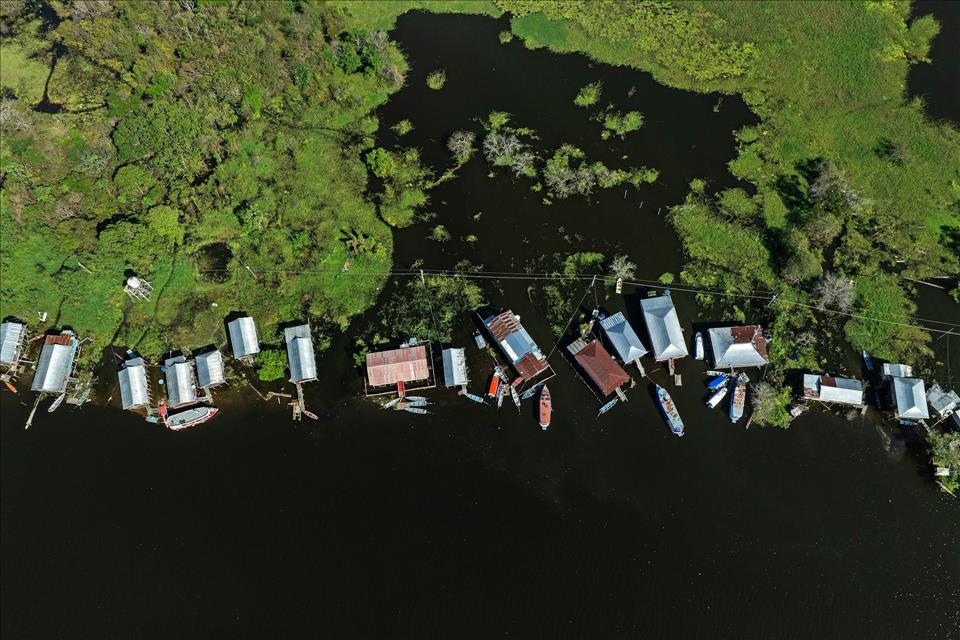
The Path To Conserving Protected Areas In The Amazon Lies In Uniting Public Policy With Traditional Local Knowledge
A recent study,“Socio-environmental Conflicts and Traditional Communities in Protected Areas: A Scientometric Analysis,” published in the Journal for Nature Conservation , mapped how scientific literature has examined these conflicts over time.
Researchers from the Federal University of Western Pará (UFOPA ), the Federal University of Pará (UFPA ), the University of International Integration of Afro-Brazilian Lusophony (UNILAB ), and the Vale Institute of Technology (ITV ) collaborated on the study as part of the National Institute of Science and Technology in Synthesis of Amazonian Biodiversity (INCT-SynBiAm ) and the Eastern Amazon Biodiversity Research Program (PPBio-AmOr ).
The team reviewed 263 scientific articles published worldwide between 1990 and August 2024, sourced from Scopus and Web of Science . Their analysis revealed significant gaps in research on this topic and offered recommendations for more just, inclusive, and effective management of protected territories.
What does science reveal about these conflicts?The research shows not only a rise in conflicts involving traditional communities and protected zones, but also their diversity. The main sources of tension are:
Access to subsistence resources: Local prohibitions-often unilaterally enacted-restrict fishing, hunting, gathering, and subsistence agriculture, all vital for food and income. These constraints sever longstanding traditions of sustainable resource use, leading to food insecurity and marginalization.For example, in Ethiopia's Nech Sar National Park , new conservation policies have curtailed local residents' access to natu re, sparking community tension and resistance.
Exclusionary management of protected areas: Community voices are rarely included in decisions about protected area creation or management. The absence of prior consultation and disregard for traditional knowledge often yield policies disconnected from local realities. Such centralized management breeds resentment and undermines conservation; participatory governance is essential to socio-environmental justice.A involving Aymaras, Atacameñas, and Mapuche-Huilliches communities found that while participatory practices and technical support from the CONAF forest agency improved perceptions, dissatisfaction persists due to initial exclusion. Many continue to assert ancestral land rights and demand meaningful input, highlighting the urgent need to build trust and align conservation with social justice.
Conflicts involving wildlife: Local communities contend with damaged crops, attacks on domestic animals, and even threats to personal safety. Large mammals such as elephants, lions, jaguars, and buffalo are the main culprits. Habitat loss and depleted food sources exacerbate these incidents. Peaceful coexistence requires inclusive, context-specific solutions.A study from Ethiopia highlighted rising human-wildlife conflict in Chebera Churchura National Park : crop invasion, livestock predation and disease, and increased risks to human life were all reported.
Territorial disputes and land rights: Many protected areas overlap with territories long used by traditional peoples. Disavowed land rights provoke legal battles, forced displacement, and greater insecurity, compounding social challenges. Formal recognition of collective land title is key to reducing conflict and ensuring autonomy; these disputes exemplify the global fight for territorial justice.In Mexico, a recent study documents the impact of land privatization, livestock expansion, plantations, and urbanization in the protected areas of Veracruz, Chiapas, and Morelos. It generated a land market that is disrupting Indigenous and peasant communities and threatening both their territories and forest conservation.
Cultural and socioeconomic disruption: Establishing protected areas can upend ways of life rooted in symbolic, generational relationships with nature. Prohibiting customary practices disrupts rituals, beliefs, and the intergenerational transmission of knowledge, silently eroding local cultures.In the United States, Australia, and New Zealand, studies have noted frequent friction between Indigenous groups, recreational visitors, and managing agencies. Issues include access to sacred sites and resources on traditional lands, visitor infrastructure, permitted activities, and even place names.
Lack of recognition and real participation: When communities are denied a voice in decisions, historical inequities deepen, fueling conflict. Despite legal progress, many traditional groups remain excluded from governance. Without meaningful participation, environmental policy fails to address local needs-highlighting the urgent need for community leadership and real power-sharing in conservation.Italy's Monti Sibillini National Park in the Central Apennines offers an instructive case: rural depopulation has coincided with rising friction between environmental managers and locals . Imposed bureaucratic guidelines, unresponsiveness to community aspirations, and challenging collaboration between the park and municipalities have generated mutual frustration and hostility. This underscores the need for“knowledge democracy” and truly participatory stewardship that respects diverse ways of living on the land.
Within Brazil, the same types of socio-environmental strife observed worldwide are especially acute in national protected areas. Research shows that even in sustainably managed zones like Extractive Reserves, communities regularly face resource restrictions and limited decision-making power-a recipe for lingering resentment and compromised conservation. Centralized authority and denial of customary land rights often lead to drawn-out disputes, mirroring patterns across the Global South.
These findings highlight Brazil's urgent need for strong co-management models-mechanisms that value local knowledge and foster territorial justice.
The main drivers of conflict reported in the study are limited resource access, exclusionary management policies, human-wildlife conflict, land disputes, threats to culture and livelihood, and lack of community recognition or participation. Image courtesy of the authors
Such tensions cluster in nature reserves and national parks, where regulatory regimes often disregard local lifeways and worldviews. Although the law guarantees consultation and participation mechanisms like free, prior, and informed consultation, they are often ignored or implemented ineffectively.
Nature reserves and national parks are epicenters of these conflicts. Image courtesy of the authors
Another key finding: 66.54% of studies focused on non-Indigenous populations, while only 16.73% examined Indigenous peoples exclusively. This imbalance exposes the under-representation of research attentive to the full range of traditional communities.
Such gaps hinder efforts to understand these peoples' rich cultural and ecological realities-and in turn, weakens recognition of their expertise and the value of their knowledge for global biodiversity conservation. Scientific consensus now affirms the vital role these communities play in preservation, yet too often they are treated as problems to be managed, not as collaborative partners.
Most scientific research focuses on non-Indigenous groups, signaling an overlooked need for studies that truly foreground traditional communities. Image courtesy of the authors Why does conservation demand inclusion?
Ensuring traditional communities participate in planning and stewarding protected lands is not only a matter of justice, but fundamental to effective conservation. Sustainable outcomes depend on their involvement. This study underscores the urgent need for public policies that are both inclusive and tailored to local conditions, embedding traditional knowledge as an indispensable part of conservation solutions, not as an obstacle.
Worldwide, co-management experiments show that community involvement fosters compliance with conservation rules, improves governance, and delivers stronger socio-environmental benefits.
Shifting the focus to Amazonian scienceWhile most studies reviewed focus on countries in the Global South-like Brazil and India-research production is dominated by institutions in the Global North. This reflects persistent“parachute science”: fieldwork by foreign scientists in rich biodiversity zones, often excluding local scientists and communities from the research process. Such projects often leave little local benefit, treating Amazonian residents as data collectors or study subjects.
Visualization indicating which countries are most actively researching these conflicts and which are most frequently studied. Image courtesy of the authors
To address this, efforts must shift toward empowering Amazonian scientific institutions and researchers , strengthening their role in shaping conservation and research agendas, and realizing epistemic justice. Investments are especially needed in institutions serving remote, often overlooked regions of the Amazon.
With robust support, these institutions can fill crucial gaps-producing research attuned to local realities, expanding our understanding of Amazonian ecosystems, and inspiring new generations of scientists.
Researchers living and working in the Amazon possess deep, context-sensitive knowledge of the territory , enabling them to pose more relevant questions and craft solutions suited to regional challenges and opportunities. Their scholarship, in ongoing dialogue with both environment and community, enriches global science and yields practical advances that matter for daily life in the forest.
Proximity to Indigenous, riverside, and urban populations also enables more authentic community participation in research . When research projects originate from local priorities and perspectives, they strengthen communities, help protect biodiversity, and affirm the possibility of uniting science, social justice, and climate action.
This article was originally published in Portuguese

Legal Disclaimer:
MENAFN provides the
information “as is” without warranty of any kind. We do not accept
any responsibility or liability for the accuracy, content, images,
videos, licenses, completeness, legality, or reliability of the information
contained in this article. If you have any complaints or copyright
issues related to this article, kindly contact the provider above.
Most popular stories
Market Research

- Koywe Joins The Borderless.Xyz Network, Expanding Stablecoin Liquidity Across Latin America
- BC.GAME Unveils New Logo, Strengthens Crypto Integration In Igaming Ecosystem
- Nodit Launches Blockchain MCP To Bring Blockchain Context To Gpts And AI Tools
- XDC Network Concludes Integration With Utila Enabling Institutional Access To Custody Assets
- Mantle And Republic Technologies Forge Strategic Partnership To Pioneer Institutional Meth Integration
- From Private Equity To Public: Trace ASI's AI For Crypto Hits 87% Success Rate





















Comments
No comment